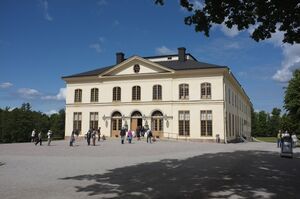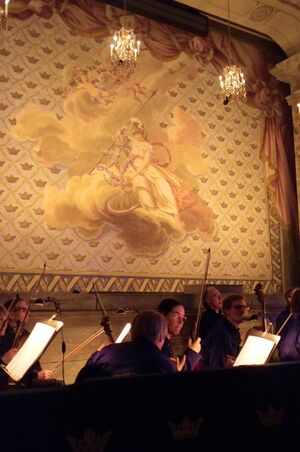The Baroque style of the 17th and 18th centuries used ornament, movement, exuberant detail and surprise to achieve a sense of awe. The Drottningholm Palace Theatre is one of the few Baroque theatres still in use, with its original stage machinery.
Drottningholm Theatre (Q34) is located on the island of Lövon about ten kilometres from Stockholm, Sweden. It is part of the former summer residence of the Swedish royals, now the Royal Palace.
The first theatre intended to serve the court opened its doors in 1754 and was built by the architect Nicodemus Tessin the Elder and his son Nicodemus Tessin the Younger (Q30563). It passed directly into the hands of the Queen Regent Hedvig Eleonora. A terrible fire burnt down the theatre during a performance in 1762. Its reconstruction was commissioned to the architect Carl Frederik Adelcrantz (Q46) in 1764 to open its doors in 1766. The new theatre, known as the ‘opera house’, boasted magnificent stage machinery by Donato Stopani.
After the death of King Adolf Fredrik in 1772, Queen Lovisa Ulrika remained in charge of the theatre until 1778, when she handed it over to her son Gustav III, the new King of Sweden, known as the ‘Theatre King’. The end of the Gustavian Period came with his assassination by gunfire in 1792 during a masquerade at the Stockholm Opera House and the subsequent closure of the theatre 20 years later.
After more than a century in which the theatre was closed and almost forgotten, Agne Beijer (Q89), an assistant at the National Library of Sweden, rediscovered it in 1921. He directed the restoration of the theatre and created the Drottningholm Theatre Museum, of which he was the director from 1925. On 19 August 1922 the theatre was reopened and the first performance was held. During the 1940s, its role as a museum still dominated, and the performances were intended to generate income for the museum and provide a space for experimentation. From the 1950s onwards, operas and ballets began to be produced on a more regular basis. Today the Drottningholms Slottstheater hosts the annual summer festival of classical opera. Since 1992 it has been a World Heritage Site.
The building has a classical French-style façade, with its front entrance facing a small square that connects it to the palace. In plan, the theatre is aligned to an axis of symmetry coinciding with its entrance and connection to the Royal Palace. A second transversal axis that passes through the side doors of the auditorium divides the stage space from the audience, becoming almost an axis of symmetry accentuated by the opposing inclinations of the stage and the auditorium. This second axis and the relationship between the building and the garden were emphasised by Gustav III’s extension. This involved the construction of a new space attached to the theatre called the Déjeuner-Salon, designed by the set designer Louis Jean Desprez in 1791 (Q30564).
The theatre has a 400-seat auditorium. Although the entire group of spectators have a good view of the stage, the ideal point from which to best experience the perspective of the stage was where the King’s seats were located in the front row. The sightlines are good as the rows of seats are parallel to each other and the hall is sufficiently inclined to allow all the spectators to see. There was a break in the rectangle of the hall with a central baroque oval linking actor and spectator. Later, it was removed, and benches were placed around it. A peculiarity of this theatre is that a curtain can be lowered between the widest main part of the auditorium and the last eleven rows of benches. In Gustav III’s time it was used to separate the high nobility and royalty from the bourgeoisie and lower nobility during intermissions and at the end of performances. The auditorium does not have balconies, but has six boxes in the middle, three on each side. They were used to seat musicians who could not fit in the orchestra pit and for kings on official occasions.
As in all Baroque theatres, the most striking effect of this theatre is the changement à vue – that is, the change of scene in full view of the audience. To achieve this effect, the theatre has a fully functional mechanism for changing wings and backdrops; this mechanism is operated from offstage and out of the audience’s view, so the stage appears to change ‘magically’ from one scene to the next, with perfect synchronisation.
The dynamics of the stage are not limited to the horizontal plane, but also include a system of clouds and flying machines capable of lowering characters from the attic and a system of trap doors and lifting platforms to make the actors appear and disappear into the substage. All of this is linked to sound effects such as thunder and wind, and lighting effects such as the dimming system that turns candles or oil lamps towards or away from the stage. The theatre is designed to create wonder, delight and awe, displaying the King’s cultural prestige to his guests and courtiers.



